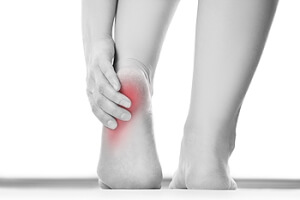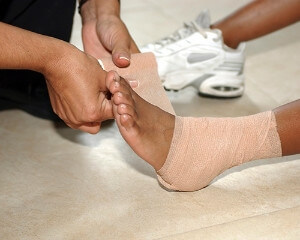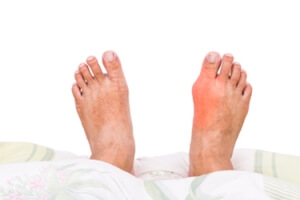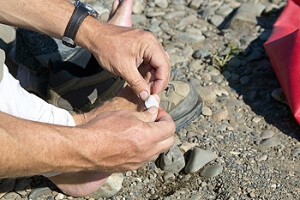
Foot and Ankle Surgery
When conservative, noninvasive methods prove ineffective, surgery may be selected as the next course of action for the treatment of your foot or ankle condition. A wide number of foot and ankle surgical procedures exist, and it is up to your podiatrist to determine which intervention will be most appropriate and helpful for your case. Some surgical procedures include bunion surgery, fusion, hammertoe surgery, heel spur surgery, metatarsal surgery, nail surgery, neuroma surgery, reconstructive surgery, skin surgery, and tendon surgery. Typically, surgery is turned to as a definitive way to alleviate excessive pain or discomfort and to return your foot to full mobility.
Regardless of the location on the body, all surgical procedures require preoperative testing and examination to ensure the surgery’s success and preferred outcome. A review of your medical history and medical conditions will take place, as will an evaluation of any current diseases, illnesses, allergies, and medications. Tests such as blood studies, urinalyses, EKG, X-rays, and blood flow studies may be ordered. Because the procedure involves the foot and/or ankle, the structures of your feet while walking may also be observed by your podiatrist.
Care post-surgery will depend on the type of surgical procedure performed. Typically, all postoperative care involves rest, ice, compression, and elevation. To improve and ensure a safe recovery, your foot and ankle surgeon may also employ the use of bandages, splints, surgical shoes, casts, crutches, or canes. He will also determine if and when you can bear weight. A timely and thorough recovery is a priority for both you and your podiatrist, and carefully following postoperative instructions can help achieve this.
Possible Causes of Plantar Fasciitis
 There is a band of tissue that is located on the bottom of the foot. This band, known as the plantar fascia, connects the toes to the heel bone. If the plantar fascia should become inflamed and irritated, a condition that is referred to plantar fasciitis may develop. Symptoms that are characteristic of this condition may include pain and discomfort, in addition to the heel appearing stiff and swollen. Typical reasons for plantar fasciitis to develop may include standing for extended periods of time or wearing shoes that do not fit properly. Additionally, this ailment may develop in patients who participate in long distance running. Certain medical conditions, such as flat feet or high arches, may be contributing factors for the onset of plantar fasciitis. Mild relief may be found while resting the affected foot, and it may be helpful to abstain from engaging in the activities that may have caused the condition. If you have heel pain, consult with a podiatrist who can offer proper treatment options.
There is a band of tissue that is located on the bottom of the foot. This band, known as the plantar fascia, connects the toes to the heel bone. If the plantar fascia should become inflamed and irritated, a condition that is referred to plantar fasciitis may develop. Symptoms that are characteristic of this condition may include pain and discomfort, in addition to the heel appearing stiff and swollen. Typical reasons for plantar fasciitis to develop may include standing for extended periods of time or wearing shoes that do not fit properly. Additionally, this ailment may develop in patients who participate in long distance running. Certain medical conditions, such as flat feet or high arches, may be contributing factors for the onset of plantar fasciitis. Mild relief may be found while resting the affected foot, and it may be helpful to abstain from engaging in the activities that may have caused the condition. If you have heel pain, consult with a podiatrist who can offer proper treatment options.
Plantar fasciitis can be very painful and inconvenient. If you are experiencing heel pain or symptoms of plantar fasciitis, contact one of our podiatrists from Sayville Foot Care. Our doctors can provide the care you need to keep you pain-free and on your feet.
What Is Plantar Fasciitis?
Plantar fasciitis is the inflammation of the thick band of tissue that runs along the bottom of your foot, known as the plantar fascia, and causes mild to severe heel pain.
What Causes Plantar Fasciitis?
- Excessive running
- Non-supportive shoes
- Overpronation
- Repeated stretching and tearing of the plantar fascia
How Can It Be Treated?
- Conservative measures – anti-inflammatories, ice packs, stretching exercises, physical therapy, orthotic devices
- Shockwave therapy – sound waves are sent to the affected area to facilitate healing and are usually used for chronic cases of plantar fasciitis
- Surgery – usually only used as a last resort when all else fails. The plantar fascia can be surgically detached from the heel
While very treatable, plantar fasciitis is definitely not something that should be ignored. Especially in severe cases, speaking to your doctor right away is highly recommended to avoid complications and severe heel pain. Your podiatrist can work with you to provide the appropriate treatment options tailored to your condition.
If you have any questions please feel free to contact our office located in Sayville, NY . We offer the newest diagnostic and treatment technologies for all your foot and ankle needs.
Plantar Fasciitis
The plantar fascia is a connective tissue in the heel that stretches across the bottom length of your foot. Plantar fasciitis occurs when the connective tissue becomes inflamed, causing heel pain and discomfort during physical activity. Although the condition is completely treatable, traditional methods can take up to a year to start becoming effective.
Plantar fasciitis is caused by a number of everyday activities, so understanding the condition is important for managing and treating it. One of the most common causes of plantar fasciitis is excessive running, especially with improper fitting or non-supportive shoes. Too much exercise can lead to the plantar fascia being overworked and overstretched, which can cause tears in the tissue. Along with improper fitting shoes, pronation, the rolling of the feet inward, is a common cause of plantar fasciitis. If not treated properly, the plantar fascia becomes overstretched and starts to tear, causing inflammation.
Despite the common causes of plantar fasciitis, there are many different treatment options. For less severe cases, conservative home remedies include taking anti-inflammatory drugs to alleviate pain, applying ice packs to the bottom of your foot and heel, slowly stretching and exercising your feet to re-strengthen the tissue, and using orthotic devices are all ways to help manage your plantar fasciitis.
For more severe cases, shockwave therapy has become a common solution for plantar fasciitis. Shockwave therapy can effectively break up the tissue on the bottom of your foot which facilitates healing and regeneration. This fights the chronic pain caused by plantar fasciitis. Even if this doesn’t work, surgery is always a final option. Surgery on the tissue itself can be done to permanently correct the issue and stop the inflammation and pain in your heels.
No matter what the case may be, consulting your podiatrist is the first and best step to recovery. Even the slightest amount of heel pain could be the first stage of plantar fasciitis. Untreated symptoms can lead to the tearing and overstretching of tissue. Because the tearing of tissue can be compounded if it remains ignored, it can evolve into a severe case. The solution is early detection and early treatment. Talk to your podiatrist about the possibilities of plantar fasciitis if you’re experiencing heel pain.
Can Exercise Help Sprained Ankles?
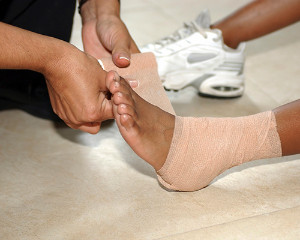 Research has shown treatments for ankle sprains may differ depending on how severe the sprain is. Mild relief may be found in resting and elevating the foot, in addition to protecting the injured area for the first several days. If the foot is wrapped in a supportive bandage, swelling may decrease. As the resting period ends, it may be beneficial to perform exercises that may help to strengthen the ankle. This may aid in regaining stability and balance that is necessary to accomplish daily activities. There are several ankle stretches that may enhance range of motion and flexibility. These may include tracing letters of the alphabet with your toes and standing on one leg for several seconds. Both of these movements may help to improve strength and ankle movement. If you have sprained your ankle, it is suggested to seek the counsel of a podiatrist who can properly treat this condition.
Research has shown treatments for ankle sprains may differ depending on how severe the sprain is. Mild relief may be found in resting and elevating the foot, in addition to protecting the injured area for the first several days. If the foot is wrapped in a supportive bandage, swelling may decrease. As the resting period ends, it may be beneficial to perform exercises that may help to strengthen the ankle. This may aid in regaining stability and balance that is necessary to accomplish daily activities. There are several ankle stretches that may enhance range of motion and flexibility. These may include tracing letters of the alphabet with your toes and standing on one leg for several seconds. Both of these movements may help to improve strength and ankle movement. If you have sprained your ankle, it is suggested to seek the counsel of a podiatrist who can properly treat this condition.
Ankle sprains are common but need immediate attention. If you need your feet checked, contact one of our podiatrists from Sayville Foot Care. Our doctors can provide the care you need to keep you pain-free and on your feet.
How Does an Ankle Sprain Occur?
Ankle sprains take place when the ligaments in your ankle are torn or stretched beyond their limits. There are multiple ways that the ankle can become injured, including twisting or rolling over onto your ankle, putting undue stress on it, or causing trauma to the ankle itself.
What Are the Symptoms?
- Mild to moderate bruising
- Limited mobility
- Swelling
- Discoloration of the skin (depending on severity)
Preventing a Sprain
- Wearing appropriate shoes for the occasion
- Stretching before exercises and sports
- Knowing your limits
Treatment of a Sprain
Treatment of a sprain depends on the severity. Many times, people are told to rest and remain off their feet completely, while others are given an air cast. If the sprain is very severe, surgery may be required.
If you have suffered an ankle sprain previously, you may want to consider additional support such as a brace and regular exercises to strengthen the ankle.
If you have any questions please feel free to contact our office located in Sayville, NY . We offer the newest diagnostic and treatment technologies for all your foot and ankle needs.
Ankle Sprains
Ankle sprains occur when ligaments that support the ankle stretch beyond their limits and tear. These types of injuries are very common and can occur in people of all ages. Sprains may range from mild to severe, depending on how much damage is done to the ligaments. If a sprain goes untreated, a more severe sprain may occur which can further damage the ankle. Repeated ankle sprains can lead to chronic ankle pain.
There are some risk factors that can increase your risk of suffering a sprained ankle. Those who participate in sports, walk on uneven surfaces, have a prior ankle injury, are in poor physical condition, or wear improper shoes are more likely to get a sprained ankle.
There are a few symptoms to look out for if you suspect you are suffering from a sprained ankle. Some common symptoms are swelling, bruising, tenderness, and instability of the ankle. In cases where the tearing of the ligaments is severe, there may be a “popping” sound when the strain occurs.
The RICE method is proven to be effective in treating ankle sprains. RICE stands for Rest, Ice, Compression, and Elevation. Rest is important for treatment, especially within the first 24 to 48 hours. You should also ice your sprained ankle for the first 48 hours for 20 minutes at a time. A small piece of cloth should be placed between the ice and the affected area. For the compression step, you should wear a brace that is snug, but not too tight that it cuts off circulation. When choosing a brace, be sure to choose one that is suitable for the type of ankle sprain you have. Lastly, you should elevate your foot above the heart as often as possible.
After you treat a sprain, you should go through rehabilitation to prevent the injury from occurring again. There are three phases to the rehab process. The first phase involves resting, protecting, and reducing the swelling of the injury. The second phase consists of restoring the ankle’s flexibility, range of motion, and strength. The third phase consists of slowly returning to activity and maintenance exercises.
If you suspect you have an ankle sprain, you shouldn’t hesitate to consult with your podiatrist. Your podiatrist will be able to give you a proper diagnosis and a suitable treatment option for your condition.
Causes of Gout
 If you have ever experienced gout, you may be familiar with the intense pain and discomfort that often accompanies this condition. This typically occurs in the big toe and surrounding areas, where it may become swollen. It happens as a result of elevated uric acid levels in the blood, and may come from eating foods that are high in purines. These types of food may include red meats, shellfish, or drinks that have high fructose levels. The excess purines can cause crystals to form in the blood, and may lodge in the joints of the toe. Research has shown that occurrences of gout may be linked to obesity and high blood pressure, or people who are afflicted with kidney disease may develop this form of arthritis. It may be beneficial to rest the foot or apply cold compresses while an attack happens. If you are experiencing gout, it is advised that you seek the counsel of a podiatrist who can properly treat this condition.
If you have ever experienced gout, you may be familiar with the intense pain and discomfort that often accompanies this condition. This typically occurs in the big toe and surrounding areas, where it may become swollen. It happens as a result of elevated uric acid levels in the blood, and may come from eating foods that are high in purines. These types of food may include red meats, shellfish, or drinks that have high fructose levels. The excess purines can cause crystals to form in the blood, and may lodge in the joints of the toe. Research has shown that occurrences of gout may be linked to obesity and high blood pressure, or people who are afflicted with kidney disease may develop this form of arthritis. It may be beneficial to rest the foot or apply cold compresses while an attack happens. If you are experiencing gout, it is advised that you seek the counsel of a podiatrist who can properly treat this condition.
Gout is a foot condition that requires certain treatment and care. If you are seeking treatment, contact one of our podiatrists from Sayville Foot Care. Our doctors will treat your foot and ankle needs.
What Is Gout?
Gout is a type of arthritis caused by a buildup of uric acid in the bloodstream. It often develops in the foot, especially the big toe area, although it can manifest in other parts of the body as well. Gout can make walking and standing very painful and is especially common in diabetics and the obese.
People typically get gout because of a poor diet. Genetic predisposition is also a factor. The children of parents who have had gout frequently have a chance of developing it themselves.
Gout can easily be identified by redness and inflammation of the big toe and the surrounding areas of the foot. Other symptoms include extreme fatigue, joint pain, and running high fevers. Sometimes corticosteroid drugs can be prescribed to treat gout, but the best way to combat this disease is to get more exercise and eat a better diet.
If you have any questions please feel free to contact our office located in Sayville, NY . We offer the newest diagnostic and treatment technologies for all your foot and ankle needs.
Everything You Need to Know About Gout
Gout, typically found in diabetic patients, is an unusually painful form of arthritis caused by elevated levels of uric acid in the bloodstream. The condition typically strikes the big joint on the big toe. It has also been known to strike the knees, elbows, fingers, ankles and wrists—generally anywhere that has a functioning, moving joint.
The high level of uric acid in a person’s bloodstream creates the condition known as hyperuricema—the main cause of gout. Genetic predisposition occurs in nine out of ten sufferers. The children of parents who suffer gout will have a two in ten chance of developing the condition as well.
This form of arthritis, being particularly painful, is the leftover uric acid crystallizing in the blood stream. The crystallized uric acid then travels to the space between joints where they rub, causing friction when the patient moves. Symptoms include: pain, redness, swelling, and inflammation. Additional side effects may include fatigue and fever, although reports of these effects are very rare. Some patients have reported that pain may intensify when the temperature drops, such as when you sleep.
Most cases of gout are easily diagnosed by a podiatrist’s assessment of the various symptoms. Defined tests can also be performed. A blood test to detect elevated levels of uric acid is often used as well as an x-ray to diagnose visible and chronic gout.
Treatment for gout simply means eliminating symptoms. Non-steroid anti-inflammatory drugs or NSAIDs (Colchicine and other corticosteroid drugs, etc.) will quell the redness, the swelling, and the inflammation. However, managing your diet, lifestyle changes, and using preventative drugs are all helpful toward fully combating the most severe cases.
Those that lead an inactive lifestyle are at a higher risk for gout. Any amount of exercise decreases the probability of repeat encounters with the condition. Reducing your consumption of red meat, sea food, and fructose-sweetened drinks also reduces the likelihood of chronic gout as well.
Ingesting Vitamin C, coffee, and particular dairy products can help with maintaining a healthy lifestyle. There are new drugs out on the market that inhibit the body’s production of uric acid-producing enzymes. However, reducing or eliminating your overall levels of uric acid is the best remedy to ensuring you lead a gout-free life.
How to Prevent Blisters When Hiking
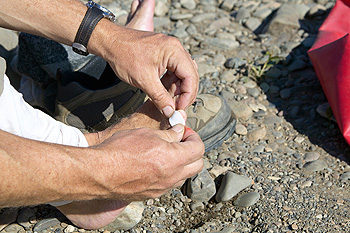 Blisters are very common, and despite being small they can be very aggravating. Blisters are even more common for people who regularly participate in physical activities. Hiking is an example of a pastime that can easily result in uncomfortable blisters, especially hiking in boots. Thankfully, there are some ways to help prevent blisters from forming. Wearing shoes that fit properly is probably the most important aspect of preventing blisters. Shoes that have been broken in are optimal because they will form around your foot naturally. Always wear socks, but preferably not cotton socks because cotton holds moisture close to the skin. Moisture helps blisters thrive, so it is best to keep your feet dry. Supportive insoles are also useful because they help keep your foot in place and prevent it from sliding around in your shoe. If you have a blister or would like more information on how to prevent blisters, speak with a podiatrist.
Blisters are very common, and despite being small they can be very aggravating. Blisters are even more common for people who regularly participate in physical activities. Hiking is an example of a pastime that can easily result in uncomfortable blisters, especially hiking in boots. Thankfully, there are some ways to help prevent blisters from forming. Wearing shoes that fit properly is probably the most important aspect of preventing blisters. Shoes that have been broken in are optimal because they will form around your foot naturally. Always wear socks, but preferably not cotton socks because cotton holds moisture close to the skin. Moisture helps blisters thrive, so it is best to keep your feet dry. Supportive insoles are also useful because they help keep your foot in place and prevent it from sliding around in your shoe. If you have a blister or would like more information on how to prevent blisters, speak with a podiatrist.
Blisters are prone to making everyday activities extremely uncomfortable. If your feet are hurting, contact one of our podiatrists of Sayville Foot Care. Our doctors can provide the care you need to keep you pain-free and on your feet.
Foot Blisters
Foot blisters develop as a result of constantly wearing tight or ill-fitting footwear. This happens due to the constant rubbing from the shoe, which can often lead to pain.
What Are Foot Blisters?
A foot blister is a small fluid-filled pocket that forms on the upper-most layer of the skin. Blisters are filled with clear fluid and can lead to blood drainage or pus if the area becomes infected.
How Do Blisters Form?
Blisters on the feet are often the result of constant friction of skin and material, usually by shoe rubbing. Walking in sandals, boots, or shoes that don’t fit properly for long periods of time can result in a blister. Having consistent foot moisture and humidity can easily lead to blister formation.
Prevention & Treatment
It is important to properly care for the affected area in order to prevent infection and ease the pain. Do not lance the blister and use a Band-Aid to provide pain relief. Also, be sure to keep your feet dry and wear proper fitting shoes. If you see blood or pus in a blister, seek assistance from a podiatrist.
If you have any questions, please feel free to contact our office located in Sayville, NY . We offer the newest diagnostic and treatment technologies for all your foot care needs.
Blisters
Blisters are small pockets of fluid that occur on the top layers of the skin for several reasons. Friction, burns, and diseases are all known causes of blisters. Smaller blisters are known as vesicles, while larger blisters are referred to as bulla. The fluid inside the bubble can be blood, pus, or serum; which is a clear liquid that protects the skin. In most cases, blisters are not a major health issue, but they can be an indicator of a more serious condition.
Causes of blisters vary. Blisters are commonly caused by wearing poorly fitted shoes that rub against the foot. However, there are many other causes besides from friction; including burns, sunburn, insect bites, frostbite, poison ivy/oak, chemical exposure, impetigo, eczema, viral infections, and more.
Most blisters heal by themselves and do not require immediate medical care. If you have a blister, do not pop it since this may cause infection; it is advised to put a bandage over the blister to protect it. If the blister is large, causes pain, or if you have a fever, it is recommended that you see a doctor who can provide proper care. Blisters are easy to diagnose, and if considered prudent by the doctor, can easily be drained of fluid with a sterile needle as well.
To prevent blisters on the feet, wear shoes that fit properly and don’t cause rubbing. Socks can help prevent friction and it is recommended that you wear them if you are wearing shoes. Hand blisters can be avoided by wearing gloves during activities that cause friction against the hand. If you have a blister that pops, do not remove the dead skin, wash the area, apply antibiotic ointment, and cover with a bandage. It is okay in most cases to not seek immediate medical care for a blister if it was just caused by friction. However, if the blister causes pain or does not go away, it is suggested that you see a doctor for a diagnosis.
Ways to Ensure Your Children’s Feet Are Healthy
 Parents are naturally concerned for all parts of their children’s health, but it is easy to sometimes forget about children’s feet. Fortunately, there are some easy ways to make sure your children’s feet are staying as healthy as they should be. Keeping feet clean and dry helps to prevent bacterial and fungal infection. Good hygiene will assist in stopping conditions like athletes’ foot, that thrive in moisture, from developing. Cutting toenails straight across will help to prevent uncomfortable ingrown toenails and showing children this technique in their younger years will help them carry this habit into adulthood. Shoes that fit properly are also essential. Children’s feet are constantly growing, so it is important to get their feet measured when buying new shoes. Tight shoes put children at a higher risk for blisters, corns, calluses, and ingrown toenails, which can all become infected. If you would like additional information about how to care for your child’s feet, then it is recommended to speak with a podiatrist to learn more about children’s foot health.
Parents are naturally concerned for all parts of their children’s health, but it is easy to sometimes forget about children’s feet. Fortunately, there are some easy ways to make sure your children’s feet are staying as healthy as they should be. Keeping feet clean and dry helps to prevent bacterial and fungal infection. Good hygiene will assist in stopping conditions like athletes’ foot, that thrive in moisture, from developing. Cutting toenails straight across will help to prevent uncomfortable ingrown toenails and showing children this technique in their younger years will help them carry this habit into adulthood. Shoes that fit properly are also essential. Children’s feet are constantly growing, so it is important to get their feet measured when buying new shoes. Tight shoes put children at a higher risk for blisters, corns, calluses, and ingrown toenails, which can all become infected. If you would like additional information about how to care for your child’s feet, then it is recommended to speak with a podiatrist to learn more about children’s foot health.
Making sure that your children maintain good foot health is very important as they grow. If you have any questions, contact one of our podiatrists of Sayville Foot Care. Our doctors can provide the care you need to keep you pain-free and on your feet.
Keeping Children's Feet Healthy
Having healthy feet during childhood can help prevent medical problems later in life, namely in the back and legs. As children grow, their feet require different types of care. Here are some things to consider...
Although babies do not walk yet, it is still very important to take care of their feet.
Avoid putting tight shoes or socks on his or her feet.
Allow the baby to stretch and kick his or her feet to feel comfortable.
As a toddler, kids are now on the move and begin to develop differently. At this age, toddlers are getting a feel for walking, so don’t be alarmed if your toddler is unsteady or ‘walks funny’.
As your child gets older, it is important to teach them how to take care of their feet.
Show them proper hygiene to prevent infections such as fungus.
Be watchful for any pain or injury.
Have all injuries checked by a doctor as soon as possible.
Comfortable, protective shoes should always be worn, especially at play.
If you have any questions please feel free to contact our office located in Sayville, NY . We offer the newest diagnostic and treatment technologies for all your foot and ankle needs.
